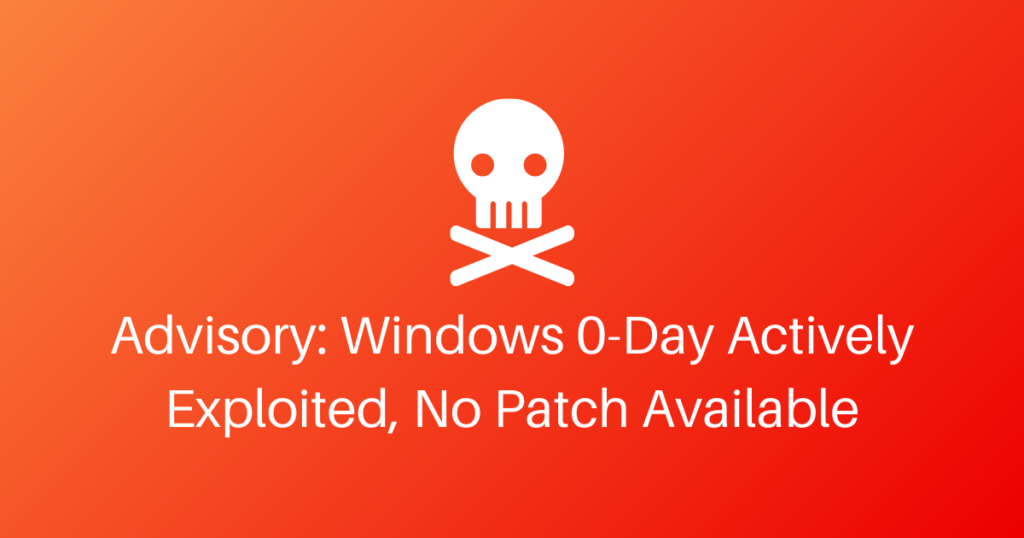
Advisory: Windows 0-Day, Actively Exploited, No Patch Available
This was an email I sent to my vCISO/CISO As A Service clients this morning. Since they do not have their own CISOs or security teams, they would not have found out about this for a while. They do have strong IT teams, though, so I provided instructions and actions they can take internally.
Team,
There is a vulnerability affecting all versions of Windows with no available patch from Microsoft. Additionally, there have been active exploits seen in the wild; however, they are currently targeted. This, of course, can change and become widespread. The exploit happens when a user opens a malicious document.
What Should You Do?
- Implement one of the first two recommended workarounds by Microsoft. I have included them below as well. The second workaround (disabling the service) can be automated by deploying a script to users using most modern endpoint agents or using a PowerShell script. These are temporary until a patch is available, so plan on reversing them.
- Remind your Windows users to be extra careful in opening documents from unknown or untrusted sources, especially if you cannot roll out the workaround within 12 hrs.
Please let me know if you have any questions or concerns.
Ayman Elsawah
vCISO & Security Advisor
Cloud Security Labs
Workarounds From Microsoft
Disable the Preview Pane and Details Pane in Windows Explorer
Disabling the Preview and Details panes in Windows Explorer prevents the automatic display of OTF fonts in Windows Explorer. While this prevents malicious files from being viewed in Windows Explorer, it does not prevent a local, authenticated user from running a specially crafted program to exploit this vulnerability. To disable these panes in Windows Server 2008, Windows 7, Windows Server 2008 R2, Windows Server 2012, Windows Server 2012 R2, and Windows 8.1, perform the following steps:
- Open Windows Explorer, click Organize and then click Layout.
- Clear both the Details pane and Preview pane menu options.
- Click Organize, and then click Folder and search options.
- Click the View tab.
- Under Advanced settings, check the Always show icons, never thumbnails box.
- Close all open instances of Windows Explorer for the change to take effect.
For Windows Server 2016, Windows 10, and Windows Server 2019, perform the following steps:
- Open Windows Explorer, click the View tab.
- Clear both the Details pane and Preview pane menu options.
- Click Options, and then click Change folder and search options.
- Click the View tab.
- Under Advanced settings, check the Always show icons, never thumbnails box.
- Close all open instances of Windows Explorer for the change to take effect.
Impact of workaround.
Windows Explorer will not automatically display OTF fonts.
How to undo the workaround.
To re-enable the Preview and Details panes in Windows Explorer for Windows Server 2008, Windows 7, Windows Server 2008 R2, Windows Server 2012, Windows Server 2012 R2, and Windows 8.1:
- Open Windows Explorer, click Organize and then click Layout.
- Select both the Details pane and Preview pane menu options.
- Click Organize, and then click Folder and search options.
- Click the View tab.
- Under Advanced settings, clear the Always show icons, never thumbnails box.
- Close all open instances of Windows Explorer for the change to take effect.
For Windows Server 2016, Windows 10, and Windows Server 2019:
- Open Windows Explorer, click the View tab.
- Select both the Details pane and Preview pane menu options.
- Click Options, and then click Change folder and search options.
- Click the View tab.
- Under Advanced settings, clear the Always show icons, never thumbnails box.
- Close all open instances of Windows Explorer for the change to take effect.
Disable the WebClient service
Disabling the WebClient service helps protect affected systems from attempts to exploit this vulnerability by blocking the most likely remote attack vector through the Web Distributed Authoring and Versioning (WebDAV) client service. After applying this workaround, it is still possible for remote attackers who successfully exploit this vulnerability to cause the system to run programs located on the targeted user’s computer or the Local Area Network (LAN), but users will be prompted for confirmation before opening arbitrary programs from the Internet.
To disable the WebClient Service, perform the following steps:
- Click Start, click Run (or press the Windows Key and R on the keyboard), type Services.msc, and then click OK.
- Right-click WebClient service and select Properties.
- Change the Startup type to Disabled. If the service is running, click Stop.
- Click OK and exit the management application.
Impact of workaround.
When the WebClient service is disabled, Web Distributed Authoring and Versioning (WebDAV) requests are not transmitted. In addition, any services that explicitly depend on the WebClient service will not start, and an error message will be logged in the System log. For example, WebDAV shares will be inaccessible from the client computer.
How to undo the workaround.
To re-enable the WebClient Service, perform the following steps:
- Click Start, click Run (or press the Windows Key and R on the keyboard), type Services.msc, and then click OK.
- Right-click WebClient service and select Properties.
- Change the Startup type to Automatic. If the service is not running, click Start.
- Click OK and exit the management application.
If this article was helpful to you, consider subscribing to my weekly newsletter, where I share my latest commentary as a vCISO for high growth startups.
Check out how we help startups accelerate and level up their security programs through vCISO (CISO As A Service) and DevSecOps As A Service.